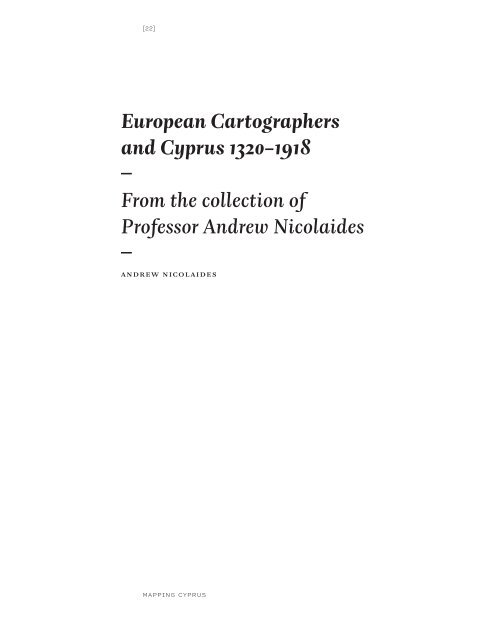pdf 1 - exhibitions international
pdf 1 - exhibitions international
pdf 1 - exhibitions international
Create successful ePaper yourself
Turn your PDF publications into a flip-book with our unique Google optimized e-Paper software.
[22] [23]<br />
European Cartographers<br />
and Cyprus 1320–1918<br />
From the collection of<br />
Professor Andrew Nicolaides<br />
Andrew nicol Aides<br />
introduction<br />
Before the discovery of printing, maps of Cyprus and the rest of the world for<br />
that matter were drawn on vellum. Those used by sailors often showed only<br />
the outline of the shores with names of ports (portolan maps).<br />
Such were the maps used on the sailing ships of the crusades.<br />
The discovery of printing soon after 1450 using movable<br />
type made books available to a large number of people speeding<br />
up dissemination of knowledge. Until then manuscripts,<br />
which were expensive, were the privilege of the rich, the church<br />
and the noble. Strangely enough, the first printed atlases were<br />
not reproductions of portolan maps, but were based on the<br />
works of Ptolemy (Claudius Ptolemaeus 100–178 Ad) of Alexandria<br />
who was a mathematician, astronomer and geographer.<br />
Ptolemy worked in the great library in Alexandria where<br />
he had access to all accumulated knowledge including astronomy,<br />
geography and history. With this, with information he<br />
collected from travellers passing through Alexandria, culturally the centre of<br />
the Hellenic world, and with his own observations he produced two important<br />
books, his Almagest a manual on astronomy and his Geographike hyphegesis<br />
(known as Geographia or Cosmographia in some Latin editions), which was<br />
a summary of the geographical knowledge at 150 Ad and a guide to drawing<br />
maps of the known world. He provided instructions for drawing the map on a<br />
globe and for three possible projections on a plane surface; also for drawing a<br />
series of regional maps and a catalogue of approximately 8,000 localities with<br />
their coordinates of latitude and longitude.<br />
With the fall of the Roman Empire the classical Greek texts were lost to<br />
the West. Western scholars had been aware of Greek authors such as Homer,<br />
Plato, and Aristotle from references in Roman texts but they did not have any<br />
access to them. Thanks to the Byzantines who copied the Greek classics, many<br />
of which were taught at school, these texts including the Geographia survived.<br />
Today there are at least 53 known Greek manuscripts in existence, some with<br />
maps, the oldest dated 1300. The West became aware of the existence of Greek<br />
MAPPING CYPRUS EUROPEAN CARTOGRAPHERS AND CYPRUS<br />
Fig. 1: Cyprus. From Cosmographia Universalis<br />
(German edition) by Sebastian Munster,<br />
Basle, 1550; 96 x 150 mm










![01 -[BE/INT-2] 2 KOL +UITGEV+ - exhibitions international](https://img.yumpu.com/19621858/1/184x260/01-be-int-2-2-kol-uitgev-exhibitions-international.jpg?quality=85)






